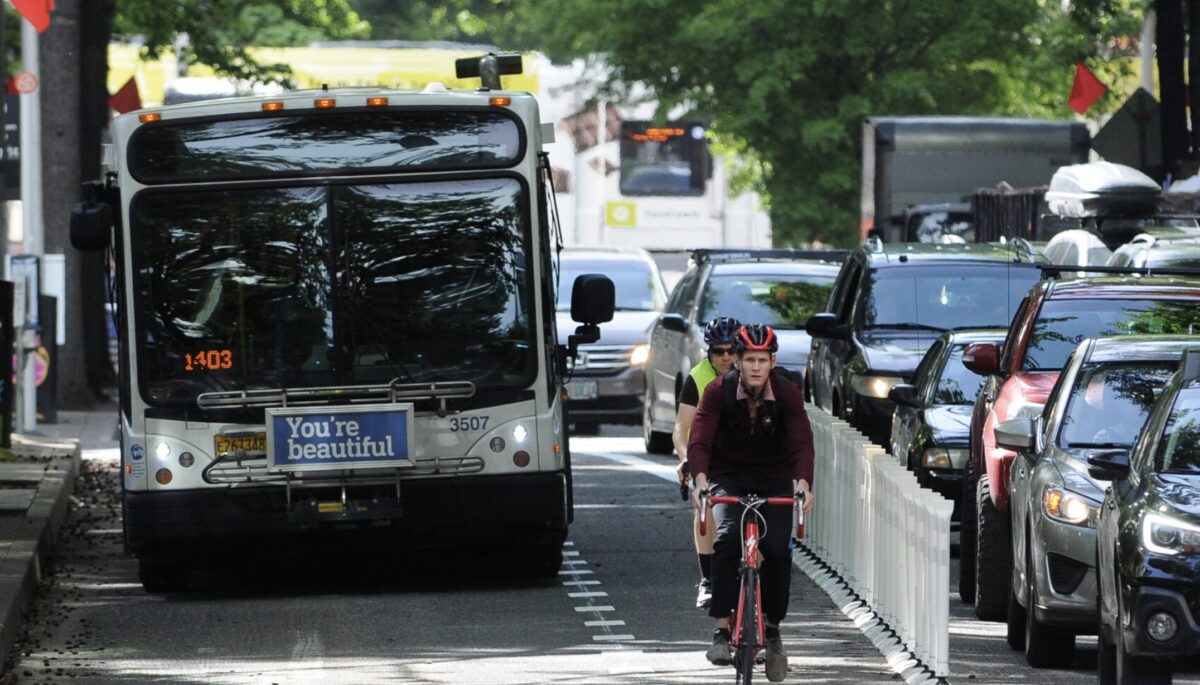
(Photo: Jonathan Maus/BikePortland)
“We’re ready to work on increasing ridership once vaccines are available.”
— Jeff Owen, TriMet Senior Planner
Transit in Portland is in bad shape. TriMet ridership numbers are in the tank and have shown no signs of recovery since the initial pandemic plummet. And transit’s most high-powered champion, City Commissioner Chloe Eudaly, is in the waning weeks of her seat on council after losing her re-election bid last month.
But the Portland Bureau of Transportation is undeterred. The agency plans to launch an online open house for the Rose Lane Project next week (12/9) as a way to build momentum for the beleaguered mobility mode.
“Covid-19 has had a profound impact on the way we get around, including Portland’s transit system,” a PBOT statement released today said. “The Rose Lane Project, however, remains a priority for PBOT. It is a down payment on the future we want. As our city recovers from the Covid-19 pandemic and traffic increases, Rose Lane improvements will keep our most important transit lines running smoothly. This will help prevent the kinds of delays transit experienced by riders in the past.”
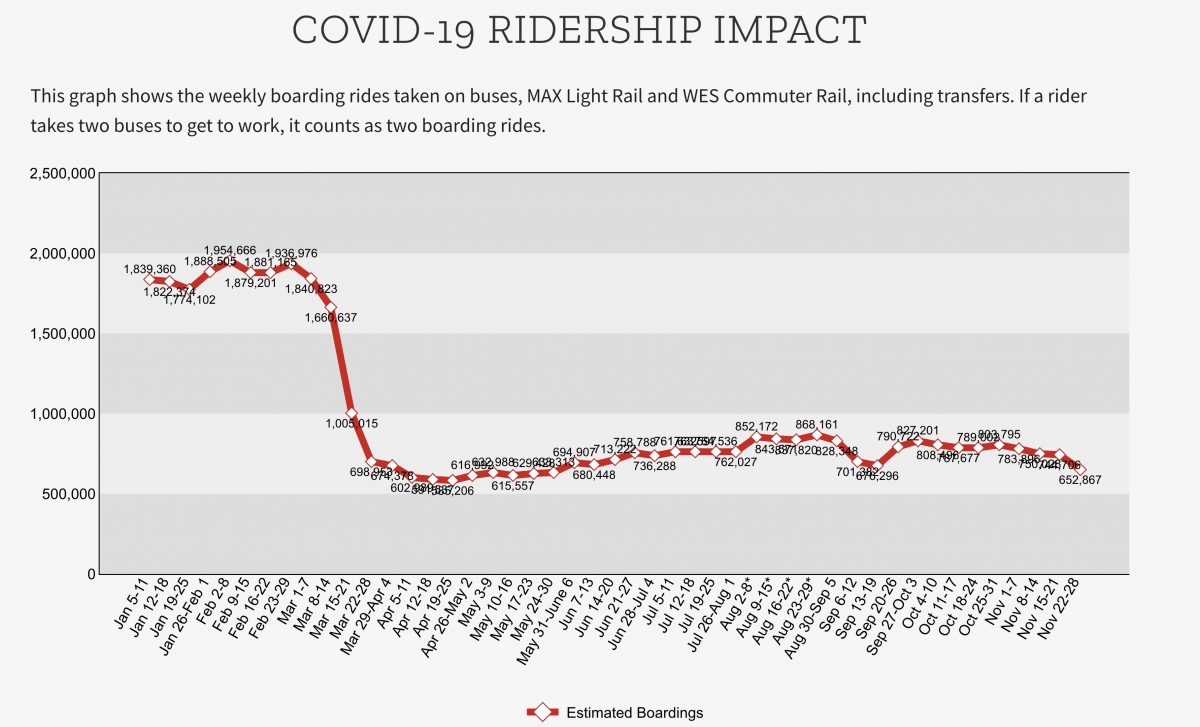
At a meeting of the PBOT Freight Committee this morning, TriMet Senior Planner Jeff Owen explained current ridership is at a level similar to when Covid first hit. One reason is because the agency is encouraging people to stay off transit unless they’re essential workers so there’s more room (and less risk) for others. “We’re ready to work on increasing ridership once vaccines are available,” Owen added. He said federal Covid bailout funds have helped TriMet survive in recent months and hinted, “There could be some good news on the horizon from additional transit support from the federal level.”
The vaccine and this additional funding — if both come through — could add even more urgency to PBOT’s Rose Lane Project work.
Launched one year ago, the Rose Lane Project was created by Commissioner Eudaly’s office to put into motion what PBOT envisioned with their Enhanced Transit Corridors plan. Several projects were completed in the first year including prefab bus islands on NW 18th and 19th, and a new bus lane on the Burnside Bridge, SW Madison, and NW Everett. While red, “Bus Only” lanes get most of the attention, Rose Lane projects can include a variety of treatments that give bus, MAX and streetcar priority over other vehicles.
While transit in Portland has lost Eudaly’s seat on Council, it has gained Commissioner-Elect Mingus Mapps. In an interview last month he told me, “I’m a bus guy” and that he has no plans to erase Eudaly’s legacy.
What remains unclear is how the big increase in work-from-homers and general changes in trip patterns might impact TriMet ridership in the long-term. Use of transit has been relatively flat in Portland in recent years and was on a slight downturn before the pandemic hit.
At their upcoming open house, PBOT says they’ll share plans for several new projects they hope to build in 2021. Hopefully they’ll also address the topic of how bike access integrates (or doesn’t) with transit-focused changes to lanes and signals.
Watch this space for the online open house and project reveals. You can learn more at the Rose Lane Project website.
— Jonathan Maus: (503) 706-8804, @jonathan_maus on Twitter and jonathan@bikeportland.org
— Get our headlines delivered to your inbox.
— Support this independent community media outlet with a one-time contribution or monthly subscription.


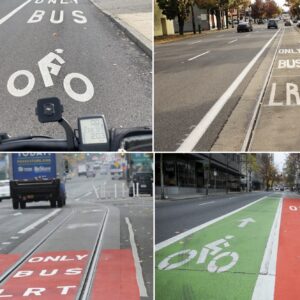
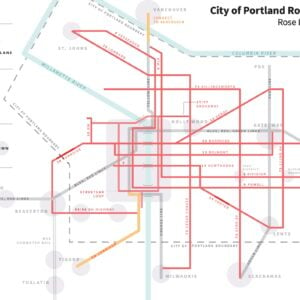
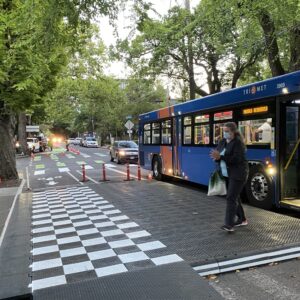
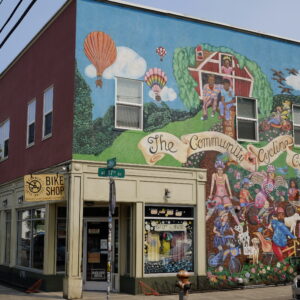
Thanks for reading.
BikePortland has served this community with independent community journalism since 2005. We rely on subscriptions from readers like you to survive. Your financial support is vital in keeping this valuable resource alive and well.
Please subscribe today to strengthen and expand our work.
Rebranding bus lanes as “Rose Lanes” was Don Draper-level genius. Calling bland, utilitarian “bus lanes” by a prettier-sounding name—one imbued with local pride (roses)—really helps sell the concept to the general public, IMO.
I can’t help but think rebranding bike/scooter/skateboard/micromobility lanes as “Green Lanes” would accomplish a similar marketing feat. Green in color, green for the environment. Pairs perfectly with Rose Lanes. None of the baggage that “bike lanes” have.
Mingus, if you’re listening…
We could call them Greenways, everyone will love them.
But sarcasm aside, I agree, branding is an important part of garnering public support for new and novel projects. Generally, people hate bikes more than “Green” stuff. So it makes sense to launder bike lanes though that lens.
That’s another reason to call them Green Lanes: they’re an extension of Greenways onto main streets.
We may well have gone beyond “peak transit.” One of the key lessons learned in the pandemic is how many office workers can work remotely. Downtown workers, including those employed by government, were a key component of transit ridership. I know several who think that their office time will never return to the previous levels. That five-days-a-week transit trip to downtown may be replaced by four days at home and one day reporting in person.
That will have ripple effects on all downtown activity including food services and others who depended on a high level of downtown office activity.
I’m one of those downtown workers. Always hated, hated, taking Trimet to work (bus or train). Now my company is talking that some workers might be full time in office, other might be full time at home, and other a mix of office and home. Nothing definite of course and leadership could do an about face and back out of that in a heartbeat, but I hope to take Trimet as little as possible in the future. I haven’t been on the train since March and haven’t missed it at all.
Could you please provide more insight on why you hate taking TriMet?
Maybe Trimet will expand crowded suburban cross-town routes by removing redundant downtown services?
Fewer downtown office workers will also make it easier and cheaper to drive and park downtown. Downtown will become just another suburban shopping center, like Washington Square.
Having to surge capacity for peak routes are second only to milk runs for poor cost-efficiency. Your fleet and employees have to be sized for the peak times of day, and the surge busses and trains that come out during rush hour get stuck in the most congestion. An all-day frequent system would be much more efficient to operate.
The problem is that for trips that are evenly distributed across the region or across the day, cars are way cheaper and easier than transit. Transit makes sense for most people for downtown rush hour trips because parking is 17 bucks and the traffic means the bus is about the same speed. For trips to a place where parking is free and evenly distributed demand means traffic isn’t that bad, you end up with 98% of people driving.
Agreed, but I would also argue that many areas of are Metro are congested all day long. Placed like HWY 26 west of downtown, I-84, and I-5 will be bad all day once the pandemic ends. Even with level demand, transit is still necessary. You also have to consider the people who cannot safely drive, or cannot afford it.
Now is the time to put a 1 year HOLD on any additional monies being spent on public transit infrastructure. It’s in decline and will be for the next year due to COVID. Redirect that money to increased police patrols to combat the insane levels of property crime occurring (bicycle theft, car theft, package theft, catalytic converter theft, car prowls). These crimes are negatively affecting quality of life for Portlanders. Once we have a vaccine and COVID is in the rear view mirror we can restart public transportation project funding.
You want to have TriMet to spend it’s budget on police patrols? That’s several layers of unworkable.
Besides, PPB couldn’t care less about property crime and they haven’t for at least a decade. They would just take the money and continue sitting around. They need six officers to respond to car wrecks so I can’t imagine how many they’d need to respond to an actual crime.
A time with low ridership is the perfect time to build the infrastructure for post-pandemic.
One of the interesting tidbits of Trimet data from the link above is that the buses and MAX trains have gradually been slowing down. In 2001 the average bus speed was 15.7 mph and MAX was 20.8 mph. In 2020 it was 13.6 mph and 18.1 mph respectively. More or less year by year there has been a constant decline in average speeds, no doubt caused by congestion.
What I find more interesting is the subsidy per ride more than doubled for the bus and tripled for the MAX during that time, from $1.47/bus ride in 2001 to $3.90 in 2020; $1.06/MAX ride in 2001 to $3.23 in 2020; and $18.46/lift ride in 2001 to $33.22 in 2020.
Trimet: Subsidy per Boarding Ride – The difference between the passenger revenue per ride and the operating cost per ride. This represents the portion of the cost of each ride that must be subsidized (primarily by taxes).
…plus more ADA boardings (~3 minutes on ave) would be another input to consider.
It would be interesting to pull out the Blue Line MAX data and compare its 2001 v 2020 times plus compare to a few key fixed route bus times for a better measure of regional congestion impacts. As for costs it does look like a big subsidy jump but when compared to an index cost (housing, state min wage etc.) it may not be too bad for a once dynamic region.
Every transit system must provide ADA service if they want federal subsidies for fixed routes, MAX, and buying buses. ADA service is far and away the most expensive portion of any transit system, including Trimet. All transit providers are looking for ways to cut costs for providing ADA service. Getting ADA users to use the regular bus (as opposed to the lift service) is a significant and proven cost-cutting method. So your excellent point about ADA boarding delays is a direct consequence of this policy.
But my question is, why are the operational costs of running MAX rising faster than the operational costs of running buses?
Ridership will continue to decline.
I think this project is great though.
I’ve said it before but will say it again; you can have lawless rolling homeless shelters or transit you want to actually use, but you can’t have both.
As a transit operator I have seen the systematic destruction of this great system. No quantity of virtue signaling can change the fact that most people would rather not deal with the chaos and problems they bring.
Please keep fighting the good fight. And thanks:)
Nope, sorry, Chloe lost the election and lost her mandate.
From the Rose Lane webpage:
“The Rose Lane Project will center the values of racial equity and transportation justice throughout its development and implementation.”
Were any of these supposed beneficiaries even consulted in the course of this project? As often discussed on this site, people of color overwhelmingly prefer to drive cars.
I would invite anyone seriously in favor of this project to come look at all the low-income folks who park their cars on NE Killingsworth east of 42nd street, where street parking is absolutely packed, and there is no throughput problem, but we are slated for Rosification.
They will lose their parking when a needless bus lane is installed, and in some cases, their homes – because they live in their cars. There’s no throughput problem here because the right of way is plenty wide.
“They can take the bus; it’s good for them, or buy e-bikes”- Chloe Eudaly.
Cue the yuppie transportation ‘wonks’, secure in their Lake Oswego / West Hills mansions with a BMW SUV or two in the garage, nodding their heads in agreement, peering over their wire-framed spectacles – indeed, the poor *should* take the bus, for it is good for the environment.
No, the poor will just scramble for off-street parking and park further from their (publicly subsidized) homes. Their lives will be made incrementally harder.
Most buses I see are empty. This is smelling redolent of Metro’s misguided insistence on the transit bond, even though everything changed. “We’ve gotta do something to stay relevant, even if it’s the wrong thing!”
People losing their homes due to bus lanes? You’re really reaching here.
1. There is plenty of side street parking in this area. People will still get to store their private property on public streets, but they might have to walk a few blocks.
2. People living out of their cars can easily park somewhere else.
> people of color overwhelmingly prefer to drive cars
I think the millions of black people riding the bus and subway in NYC (not to mention countless other cities with better public transit than Portland) would disagree with you.
Maybe they can help chip in to fund TriMet.
Yep, everyone needs to have “skin in the game”. If someone else pays for a service it is always a great idea. More free empty buses, great idea. Empty buses that cost me 50 cents, horrible idea.
No one is proposing that they increase service. Where are you getting the “more empty busses” position from?
Everyone just take a breath. These are unprecedented times, so it is completely unfair to critique Trimet for running some empty busses around. Should we demolish the Smart Park garages downtown because they are empty right now?
So glad Chloe is gone! Almost as happy as that as having the orange haired guy gone! So glad these two extremists (one left, one right) will be out of my life soon.
As someone who grew up in New York City (the Bronx), one of my continued culture shocks living here is the level of hatred for public transit by so many in the Portland metro. I guess the Western frontier spirit lives on.
It’s just that we have a memory of a much better past. Unlike NYC, we had an innovative, clean, efficient transit system as recently as 2000. Then the cost cutting, poor management and ineffective board oversight.
Increases in SOV traffic that cripples busses local streets has done more damage than anything Trimet can control. The Rose Lane project aims to fix this.
The Rose Lanes Project was adopted by City Council and is thus adopted policy, whether or not Chloe is on the commission. Hopefully soon, we’ll move to a city manager in charge of city bureaus and links between individual politicians and how bureaus are run will mostly go away.
Folks can pontificate all they want about the future of transportation and the death of mass transit, but the future is unclear, as it has been for the last ten years with new technology disrupting the industry. Was is clear is that the climate crisis is not going away (it’s becoming more dire), the region doesn’t support very costly increases in road capacity so that a Lyft/Uber driver can carry everyone from one place to another, transit supports healthy cities whether biking and walking are more viable, and the Rose Lanes project is one of the most efficient and low-cost ways to support improved transit service.
Fixed schedule, fixed route bus service no longer feels like the future, especially if recent changes in work patterns become permanent.